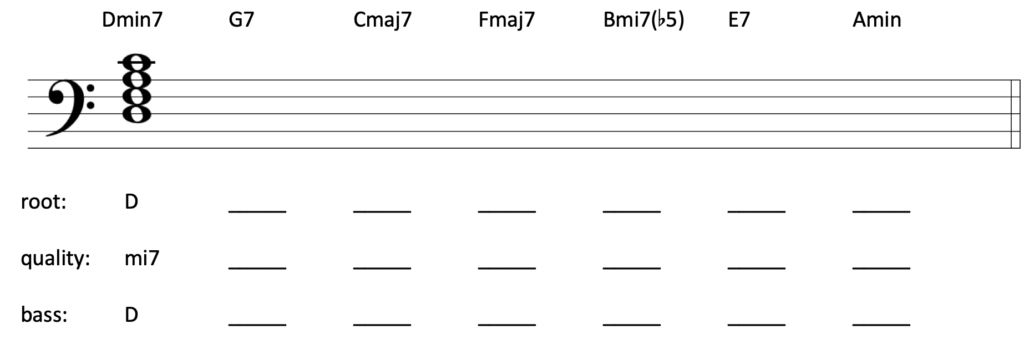Main Body
11 Lead sheet symbols
Learning goals for Chapter 11
In this chapter, we will learn:
- The most common lead sheet (chord) symbols
- How to realize chords from a lead sheet
- How to identify chords in staff notation using lead sheet symbols
Lead sheet (chord) symbols
are commonly used in a variety of popular genres, such as jazz, blues, and church music, and they generally have the following features:
- a melody notated on a single staff (with or without lyrics)
- chord symbols placed above the staff
Chord symbols on a lead sheet tell the performer(s) what chords to play in an accompaniment. These chords may be voiced in different ways (open or closed voicings, with various notes doubled) and played in a variety of textures (arpeggiated, blocked chords, and so forth). Figure 11‑1 shows the most commonly used chord symbols for triads and seventh chords in lead sheets.
Figure 11‑1. Key to understanding chord symbols
Video: T27 Lead sheet symbols in “Shenandoah” (7:04)
This interactive video walks you through the process of realizing the chords in a lead sheet, using the lead sheet for “Shenandoah” as an example. The video concludes with two different musical realizations—one using a blocked chord texture and the other using arpeggiation. To go through this example on your own, see Exercise 11-1.
EXERCISE 11-1 Chord symbols in “Shenandoah”
Listen to and study the lead sheet of “Shenandoah,” which appears in Worksheet example 11‑1. Then realize the chord symbols in this song on the staff provided or on a separate piece of staff paper.
Worksheet example 11‑1. Lead sheet for “Shenandoah”
Listen to this song, performed by Pete Seeger, on Spotify.
Learn about American folk singer and songwriter Pete Seeger (1919–2014) by reading this Oxford Music Online article, written by Dave Laing.
How would the symbols used in this lead sheet be realized in musical notation?
EXERCISE 11-2 Lead sheet chord symbols identification
For each of the chords, provide an appropriate lead sheet symbol above the staff. Beneath the staff, provide the root, quality, and bass. The first is done for you.
SET 1
SET 2
EXERCISE 11-3 Lead sheet realization
Listen to the following excerpts and study the lead sheets below. Given the lead sheet symbols used in each example, write each chord on the blank staff provided or on a separate sheet of staff paper, and then provide the root, quality, and bass on the blanks provided beneath the staff.
Worksheet example 11‑2. Joseph Kosma and Johnny Mercer, “Autumn Leaves,” mm. 1–8
Worksheet example 11‑3. Paul Simon, “April Come She Will,” mm. 1–5
Listen to the full track, performed by Simon and Garfunkel, on Spotify.
Learn about American singer-songwriter Paul Simon (b. 1941) by reading this Oxford Music Online article, written by David Brackett.
Worksheet example 11‑4. Jaime Cortez, “Rain Down,” refrain
Want more practice constructing chords from lead sheet symbols? Try these drills:
Practice constructing triads from lead-sheet symbols (teoria)
Practice constructing seventh chords from lead-sheet symbols (teoria)
EXERCISE 11-4 Transcription with triads in pop music
The examples in this exercise use triads in various inversions. Combine your knowledge of triad construction and lead sheet symbols with careful listening to transcribe short passages from each example.
Listen to Worksheet example 11‑5. This recording primarily uses three chords: F/C, Amin/C, and C. Spell these chords on a separate sheet of staff paper. Then on the staff below or on a separate sheet, transcribe the chords in the rhythm you hear when they are played in the audio recording.
Worksheet example 11‑5. Grizzly Bear, “Two Weeks,” 0:00–0:24
Listen to Worksheet example 11‑6. This recording uses Cmin/G, E![]() /G, A
/G, A![]() , and E
, and E![]() /G. Spell these chords on a separate sheet of staff paper. Then on the staff below or on a separate sheet, transcribe the chords in the rhythm you hear when they are played in the audio recording.
/G. Spell these chords on a separate sheet of staff paper. Then on the staff below or on a separate sheet, transcribe the chords in the rhythm you hear when they are played in the audio recording.
Worksheet example 11‑6. Arcade Fire, “We Used to Wait,” 0:09–0:27
Listen to the full track on Spotify.
Learn about 21st-century Canadian indie rock band Arcade Fire by reading this Oxford Music Online article, written by Ryan R. McNutt.
Listen to Worksheet example 11‑7. This recording uses: C, Emin/B, Amin/C, and Emin/B. Spell these chords on a separate sheet of staff paper. Then on the staff below or on a separate sheet, transcribe the chords in the rhythm you hear when they are played in the audio recording.
Worksheet example 11‑7. Amadou & Mariam, “Sabali,” 0:23–0:55
Supplemental resources for Chapter 11
- This recording uses a slightly different harmonization than the one shown in musical notation. Instead of A7/E, it uses a minor seventh chord (Amin7), and the ending is slightly different, too. ↵
type of score that usually contains a melody with or without lyrics on a single staff and chord symbols appearing above the staff














